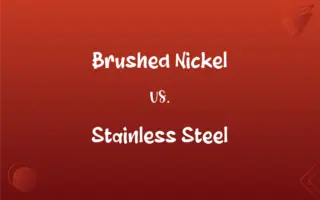Ductility vs. Malleability: What's the Difference?
Edited by Aimie Carlson || By Harlon Moss || Updated on October 24, 2023
Ductility refers to a material's ability to stretch without breaking, while malleability is the capability of a substance to be hammered or rolled into thin sheets without breaking.

Key Differences
Ductility and malleability are properties of metals, detailing their plastic deformability. Ductility concerns a material's ability to elongate under tensile stress, whereas malleability addresses deformation under compressive stress.
To visualize ductility, think of metals that can be drawn into wires. This stretching without breaking is the essence of ductility. Conversely, malleability brings to mind metals shaped into thin sheets by hammering or rolling; a key feature of malleable substances.
Often, metals with high ductility also possess significant malleability. However, these terms aren't synonymous. Ductility is showcased when metals stretch, and malleability shines when they're flattened.
Certain external factors, such as temperature, can affect both ductility and malleability. Elevated temperatures typically enhance ductility but might decrease a metal's malleability.
It's pivotal for industrial processes to understand these properties. The ductility of copper, for example, facilitates wire production. Meanwhile, the malleability of gold allows its transformation into thin gold leaf.
ADVERTISEMENT
Comparison Chart
Type of Stress
Tensile (pulling)
Compressive (pressing)
Visual Representation
Drawn into wires
Hammered or rolled into sheets
Mechanism
Stretches without breaking
Flattens without breaking
Affected by Temperature
Increases with temperature
Might decrease with temperature
Common Examples
Copper, aluminum
Gold, silver
ADVERTISEMENT
Ductility and Malleability Definitions
Ductility
Measure of a substance's stretchability.
The ductility of a metal is vital for its industrial use.
Malleability
Characteristic indicating how easily a material can be flattened.
Aluminum showcases its malleability in the creation of foils.
Ductility
Characteristic allowing elongation without rupture.
The ductility of steel enables the creation of long bridges.
Malleability
Ability of a metal to deform under compressive stress without breaking.
The malleability of silver aids in making decorative items.
Ductility
Ability of a material to deform under tensile stress.
Copper's ductility makes it ideal for electrical wires.
Malleability
Quality of a material to be rolled or beaten into various shapes.
The malleability of metals has been exploited since ancient times.
Ductility
Deformation property under applied force.
High ductility ensures metal structures can bear heavy loads.
Malleability
Capacity to undergo shape change without fracture when pressure is applied.
Metals' malleability is crucial for many manufacturing processes.
Ductility
Quality indicating how easily a material can be drawn into a wire.
The ductility of platinum is evident in its wire forms.
Malleability
Property allowing substances to be hammered into thin sheets.
Gold's malleability is demonstrated in gold leaf artistry.
Ductility
Easily drawn into wire or hammered thin
Ductile metals.
Malleability
Capable of being shaped or formed, as by hammering or pressure
A malleable metal.
FAQs
Are ductility and malleability the same thing?
No, while both refer to the deformability of materials, ductility is about stretching into wires, and malleability is about flattening into sheets.
How is "malleability" defined?
Malleability describes a material's capacity to be hammered or rolled into thin sheets without breaking.
Can a material be both ductile and malleable?
Yes, many metals, like gold, exhibit both ductility and malleability.
Does temperature affect ductility and malleability?
Yes, materials can become more or less ductile or malleable depending on their temperature.
Are all metals both ductile and malleable?
No, while many metals exhibit these traits, some can be brittle or lack malleability.
What happens to a material when it loses its ductility?
When a material loses its ductility, it becomes more brittle and is more likely to break under tension.
Are there real-world applications where both ductility and malleability are desired?
Yes, coin-making, for instance, requires metals that are both ductile (for detailed pressing) and malleable (to create flat surfaces).
What materials are generally known for their malleability?
Gold, silver, and aluminum are examples of highly malleable metals.
Is steel more malleable or ductile?
Steel is generally more ductile than malleable, but its exact properties can vary based on its composition.
How do industries test for malleability?
Compression tests, where materials are flattened, can help measure malleability.
What does "ductility" mean?
Ductility refers to a material's ability to be drawn into a thin wire without breaking.
Why are ductility and malleability important in material science?
These properties influence how materials can be shaped, used, or processed in various industries.
How does increased malleability benefit industries?
Increased malleability allows materials to be shaped more easily, which can be crucial in industries like jewelry-making or metalworking.
What role does atomic bonding play in ductility and malleability?
The type of atomic or molecular bonding in a material often dictates its mechanical properties, including ductility and malleability.
Which materials are typically ductile?
Metals, especially gold and copper, are often considered ductile.
Is gold's malleability the reason for its use in thin gold leaf?
Yes, gold's high malleability allows it to be hammered into extremely thin sheets, suitable for gold leaf.
Can ductility affect a material's electrical properties?
Yes, highly ductile metals, like copper, are often used in electrical wiring due to their ability to be drawn into thin wires.
Does increased hardness in a material reduce its ductility?
Generally, as hardness increases, ductility decreases, but this can vary based on the material and its treatment.
Can ductility and malleability be improved or altered?
Yes, through processes like alloying or heat treatment, these properties can be modified.
Are there tests to measure ductility?
Yes, one common test is the tensile test, which measures how much a material can stretch without breaking.
About Author
Written by
Harlon MossHarlon is a seasoned quality moderator and accomplished content writer for Difference Wiki. An alumnus of the prestigious University of California, he earned his degree in Computer Science. Leveraging his academic background, Harlon brings a meticulous and informed perspective to his work, ensuring content accuracy and excellence.
Edited by
Aimie CarlsonAimie Carlson, holding a master's degree in English literature, is a fervent English language enthusiast. She lends her writing talents to Difference Wiki, a prominent website that specializes in comparisons, offering readers insightful analyses that both captivate and inform.































































